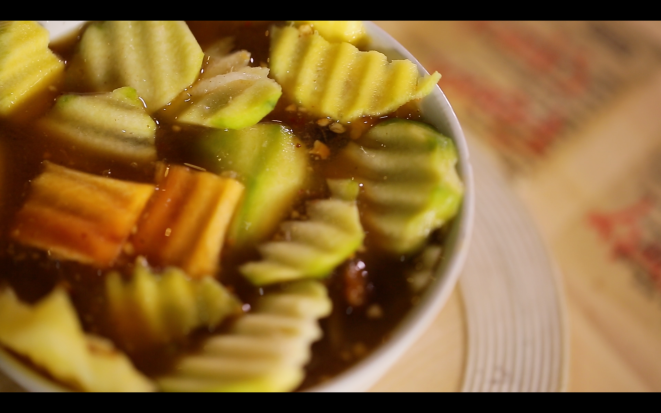
A signature fruit salad by Rujak Kolam Medan, using organic fruits and special dressing with crushed-cashew. Shot by : Anton Sugiharto
Alan Davidson in Oxford Companion to Food called rujak buah as the most eccentric fruit salad for adding spiciness in it. Moreover, Indonesia’s rujak is not only made of fruit with sweet and spicy dressing as internationally known.
Rujak can not be identified by one characteristic. Even the basic ingredients could differ from one to other region. Rujak buah can be found easily in various places in Indonesia. But I would say rujak buah from Rujak Kolam Medan as a top-notch.
I visited Rujak Kolam Medan (RKM) in October 2017 with Food Story Kompas TV team. RKM used organic fruits in its recipe. So the incredible taste started since the fruit is sliced and dropped onto a plate. The fresh fruit harvested from its own garden. I took example of watery rose apple. The watery rose apple was said to be Citra type. This type has bright red color during dry season or dark red color during rainy season. It tasted sweet legit with a little sponge-like texture, which is perfect for salad.
The dressing is also great. RKM can even sell the dressing only! Obviously the dressing is the heart of this rujak. RKM refused to reveal any details about ingredients in its dressing. But in general, my tongue recognized peanuts, cashews, shrimp paste, and pisang batu (musa balbisiana). Then it turned out that RKM also used gohok (syzygium polycephalum) that has a sour taste. Cashews in the dressing were only crushed roughly to keep its texture and savory taste in it. You can’t resist it!
Rujak Kuah Pindang
Rujak kuah pindang is a distinct kind of rujak from Bali. It offers double savory taste, both from shrimp paste and fish broth. Although it is like a rujak buah in general, the presence of fish broth sauce became a striking difference. You can’t smell any fishy aroma, thanks to the lemongrass and bay leaves infused to the broth. It gave me some savory and fresh sour taste with aromatic fragrance while chewing fruits.

Rujak Kuah Pindang, a fruit salad with fish broth and spicy sugar palm sauce from Bali. Shot by : Herri Ardi
Rujak Seafood (Seafood Salad)
Indonesia also has a seafood salad. If you visit Pancoran Street, Glodok, Jakarta, rujak seafood named Rujak Shanghai Cik Encim is worth a try. Rujak is made from juhi or large cuttlefish and jellyfish (which is certainly edible).
Juhi and jellyfish were boiled about 5 minutes to avoid the tough texture. After that, juhi and jellyfish were arranged together with pickled cucumber and turnip, blanched kale, fine-crushed garlic, chilli sauce, tomato sauce, thick pink sauce, lime juice and mashed fried-peanuts.
Thick pink sauce is secret recipe. The only ingredient I know is only sago starch so the sauce is really thick.

Rujak Shanghai Encim, a signature seafood salad in Glodok area, Jakarta, Indonesia. Shot by : Herri Ardi
It was my first time trying the seafood salad. The presentation didn’t attract me but I was curious about the taste. The flavor and aroma are dominated by garlic which slightly disguised the fishy smell of juhi. Then followed by a sour taste of lemon, the sweetness of the pink sauce, and nutty sensation. I also added more lemon juice to eliminate strong fishy smell of it.
But this complex taste didn’t blend with juhi or jellyfish. Juhi and jelly was tasteless, as if separated from the dressing. I tend to cook juhi or marinate it with spices so it blends completely completely with the dressing.
Rujak Cingur
Rujak cingur from Surabaya could prove diversity in Indonesian’s rujak. This salad included meat element into it. I was confused how to match vegetables, fruit, and chewy cingur in one dish. Cingur is the snout part of the cow (the nose and the surrounding area). Its texture is similar to kikil from cow legs. Most of people are afraid or rather disgusted by the presence of cingur in this dish. Especially when looking at raw cow snout that usually displayed with another ingredients.
I also asked Lifa – the second generation of Kantin Pak Hadi in Menteng area, Jakarta that served rujak cingur from 90’s – about why cingur can get into rujak. It turns out that Lifa also didn’t know the origin of it or how cingur could be part of rujak.
I tried rujak cingur in Kantin Pak Hadi in Menteng area, Jakarta, Indonesia. Cingur was cut into small pieces and then cooked with spices before serving. Because it is cooked, then I dare to try it .. hahaha.
In addition to cingur, another character that stands out is the savory from petis and shrimp paste. Petis really ‘kicked’ in my mouth. It could be a reason for people unwilling to try this typical East Java snack, including me.




